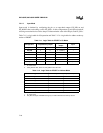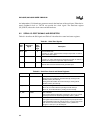
8-1
CHAPTER 8
SERIAL I/O (SIO) PORT
A serial input/output (SIO) port provides a means for the system to communicate with external
devices. This device has a serial I/O (SIO) port that shares pins with port 2. This chapter describes
the SIO port and explains how to configure it. Chapter 7, “I/O Ports,” explains how to configure
the port pins for their special functions. Refer to Appendix B for details about the signals dis-
cussed in this chapter.
8.1 SERIAL I/O (SIO) PORT FUNCTIONAL OVERVIEW
The serial I/O port (Figure 8-1) is an asynchronous/synchronous port that includes a universal
asynchronous receiver and transmitter (UART). The UART has one synchronous mode (mode 0)
and three asynchronous modes (modes 1, 2, and 3) for both transmission and reception.
Figure 8-1. SIO Block Diagram
The serial port receives data into the receive buffer; it transmits data from the port through the
transmit buffer. The transmit and receive buffers are separate registers, permitting simultaneous
reads and writes to both. The transmitter and receiver are buffered to support continuous trans-
missions and to allow reception of a second byte before the first byte has been read.
SP_CONSP_STATUS
SBUF_TX
SBUF_RX Receive Shift Register
Transmit Shift Register
RXD
TXD
Control Logic
Baud Rate
Generator
TI
RI
Interrupts
T1CLK
MSB
1
0
Internal
Data
Bus
SP_BAUD
A3070-02
Internal
Clock
Signal
Prescale
(
÷
2)
SP_CON.6
Note: The prescale circuitry is unique to the 80C196NU.


















